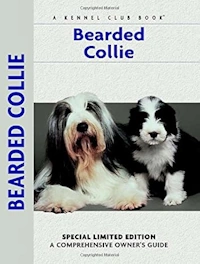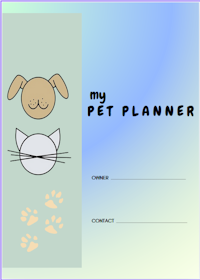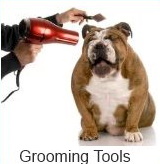Bearded Collie - Everything You Need to Know About This Smart, Entertaining Breed!
The Bearded Collie is a medium-sized friendly, energetic, and highly intelligent dog that makes a wonderful family companion.
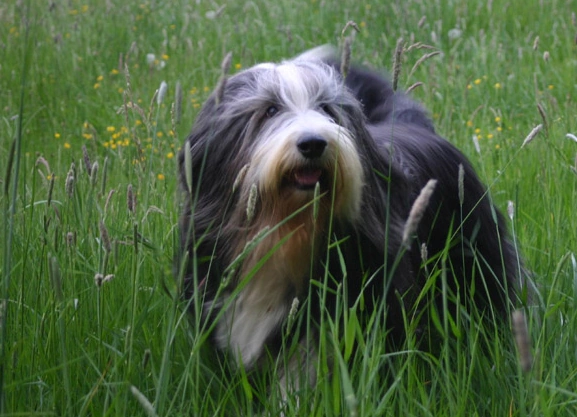 By Balbriggan
By BalbrigganTABLE OF CONTENTS
Originally the Beardie, as he is affectionately known, was used to herd sheep and cattle in Scotland. These days, he is mostly a family pet or show dog, but in some areas of Britain, he is still prized and called upon for his herding talents on farms.
The Bearded Collie was once known as the Hairy Mountain dog, and later as the Scottish Bearded or Highland Collie. His genealogy is somewhat cloudy, but it is speculated that he is from the same stock as the Old English Sheepdog and the Polish Lowland Sheepdog.
In 1989, a Bearded Collie named Potterdale Classic of Moonhill, won the Best In Show Award at Crufts prestigious dog show.
Characteristics
The Beardie is a smart, independent thinker - heck, he didn't get to be a world class herder without being able to make decisions!
While they
can be a bit stubborn, when they think they know better, the Beardie is also characteristically very affectionate and social and loves being around family.
Beardies have high energy, often described as rambunctious. Playful and lighthearted, this dog goes about his daily life in a joyful manner.
Appearance of the Bearded Collie
Although he bears a strong resemblance to the Old English Sheepdog, he is slightly
smaller and thinner and has a body length greater than his height.His coat is also straighter.
Height: 20-22 inches
Weight: 40-60 pounds
Color Variations:
The Standard basic coat colors
of the Bearded Collie include: Black, Brown, Blue and Fawn - often in combination with white markings.
Most Beardies carry a fading gene, and as they mature, the coat lightens, going through several changes of color before darkening again slightly after one year of age.
Puppy litters may include every coat color - called a rainbow litter - but since they are born with very dark or black coats, it is hard to determine which adult color they will eventually be.
However, there is one clue to that final color, and that is to look at the tips of the ears, as this hair does not fade as they mature. Also the color of the skin around the eye rim and on the nose and lips is another indicator.
The Beardie has a muscular and long lean body, with straight front and back legs covered completely with shaggy hair. The tail, which hangs low to the ground, is also covered with abundant hair and curved toward the end.
The feet are oval-shaped with well padded soles, arched toes close together, and thickly furnished.
The ears are medium in size, hang loosely and are covered with long hair.
The base of the ears will tend to rise up when something worth investigating or exciting gets the Beardie's attention.
The large eyes
with arched eyebrows
are set wide apart and convey affection and softness, while the facial expression is one of intelligence and curiosity. Eye color will generally be in a shade that reflects the coat color. In a blue or fawn, the lighter eyes are expected.
The teeth are strong and white, come together in a scissors bite.
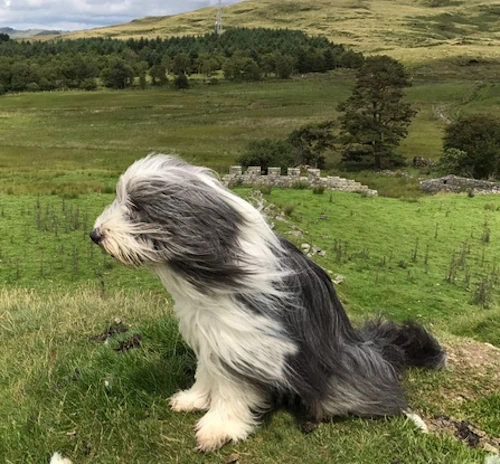
Grooming the Bearded Collie
A distinctive feature of the Beardie is his shaggy, flowing and
abundant double coat that is
straight and coarse on top and softer and fluffy on the undercoat. Without doubt,
his "shaggy dog" appearance it the signature feature that makes him so
attractive and charming to his many admirers.
That being said, this type of coat sheds a lot and even more so twice a year for up to four weeks when you'll have to up your grooming game.
Since considerable grooming is needed to keep hair from piling up around the house and is a very important part of the Bearded Collie's care, it's something that prospective owners need to consider.
Neglecting this type of coat could turn into a pet parent's
worst nightmare, so let's talk about what's involved!
Regular brushing three or four times a week is needed to maintain this beautiful coat in shiny and healthy condition, as it will develop mats and tangles in a heartbeat if ignored.
Start with a regular pin brush to remove debris and dirt. The polished tips will do this without damaging the coat.
A slicker brush is ideal for the rest of the job. Choose one with stainless steel fine pins to remove loose hair and gently detangle any areas that are more prone to matting such as the top inner leg crevices, the long tail and in the beard.
The right slicker brush will do this without
causing discomfort to your pet and you won't have to do any tugging if
you brush often, before the hair has a chance to form tangles.
If you do encounter any mats that present a problem, try a detangling spray as well as reading the guide I've written on the best way to handle mats and tangles.
A
Beardie puppy's soft coat
will start to come out at 9 to 18 months old and should be brushed a
couple of times a week to help it along and prevent mats from forming.
Owners of Bearded Collies that are not going to show dogs may
decide to have their coats cut shorter and styled in different ways.
While this will not cut down on shedding, it may be a little easier to
maintain.
In addition to maintaining a Beardie's coat, here are the other areas that need regular attention:
Ears: The long hair over a Beardie's ears can easily trap moisture, setting up the ideal environment for infection or parasites. Inspect them weekly for any troubling signs that may need your vet's attention. You can safely clean them by following this guide for ear cleaning and care here.
Bathing your Beardie can be done about every four or five weeks unless he has been into something messy. Doing it more often than needed is not recommended for skin health.
Nail trimming is not something most pet parents like to do, but when you hear them clicking around the house, you'll have to bite the bullet because long nails can cause problems. You may not have to do this often if your Beardie takes his walks on paved streets or runs around on a patio.
If
your dog runs at the sight of nail clippers, or has black nails where the quick
is harder to see, you can solve the problem with a dremel. Check out this amazing tool for a much less traumatic way to handle a nail trim.
Paws can be the target for foxtails, scratches, cuts, painful cracks, infections and broken nails. Include a paw inspection once a week - you can read our guide to paw care here.
Dental Hygiene: Brushing your Beardie's teeth every day is an important part of his overall health. Without care, the build up of plaque and tartar can lead to decay, gum disease, and many other oral problems.
If you need help to get started, check out my complete guide to brushing a dog's teeth.
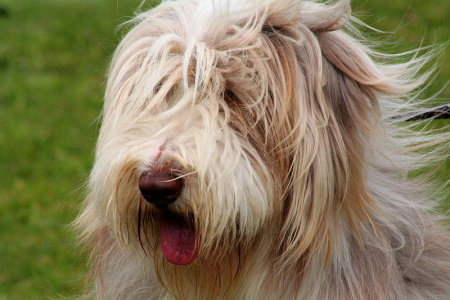 Bad Hair Day?
Bad Hair Day?Bearded Collie Temperament
If you're looking for an ideal family pet, this breed would be an excellent choice.
He is charming, sociable, exuberant,
affectionate and playful. He is also very entertaining in a jolly way and responsive to people. He would do quite well chit-chatting at cocktail parties if he were human.
On the other hand, an owner does need to establish a strong leadership
role with this breed, otherwise the Beardie, being quite manipulative, will happily take over the role as pack leader. Well, you can't blame him, it's in his genes.
On the plus side, a
dog this intelligent is very trainable if you play your cards right.
Training the Bearded Collie
One big thing in your favor when training a Beardie is their high intelligence, but it can work against you if you haven't established your leadership from the start.
Ideally, enroll your Beardie in puppy school to lay the foundation for basic obedience, socialization and of course the benefit of bonding with you as a bonus. Here, he will learn how to interact with other dogs and humans.
Keep the socialization going by introducing your dog to everything around him, including different places and common events.
One of the best ways to approach training with a Beardie, or for that matter any dog who has a strong independent streak, is through praise.
Get the praise going with small stuff and go from there. They are very smart and given enough praise, will really amaze you with what they can learn.
When training a Beardie, you'll want to make it fun and interesting as, like most smart breeds, they are easily bored with repetitive commands. Likewise, training in short sessions is better for the same reason.
Also, stay positive and be patient before you judge your pet as stubborn. Make sure they understand the exercise you are trying to teach and throw in some motivation in the form of an occasional treat if that inspires his cooperation.
As you train your Beardie, observe what training style/technique he responds to the best for keeping his attention on you and the task, then keep that in mind with every training session.
Watch your boy language so that you don't convey any frustration you may be feeling, because he will pick up on any negative messages and you may lose his focus. Play with him a little if tension arises.
Overall, fairness and positive reinforcement will work the best.
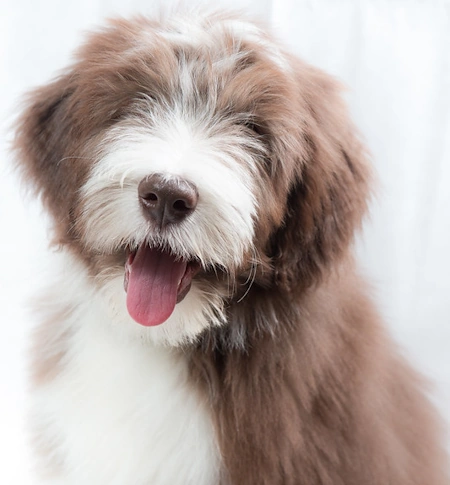 By B.Moss
By B.MossBearded Collie Health
Bearded Collies bred by a reputable breeder will generally enjoy the benefit of good health. That's because a diligent breeder researches several generations for inheritable diseases with the view of choosing the best sire and dam for mating and producing healthy litters.
However, there are some health issues, both common and inheritable, that may affect the Beardie during its lifetime.
Those include:
- Hip Dysplasia A genetic joint disease that results from the malformation of the hips and is characterized by joint weakness, stiffness, and pain. Depending on the severity of the condition, a veterinarian may advise pain medication or surgery.
- Addison's Disease is a disorder resulting from an insufficient production of hormones by the adrenal cortex. It is recognized by signs of muscle weakness, lethargy, weight loss and gastro-intestinal upsets.
- PRA (Progressive Retinal Atrophy) which is linked to a recessive gene mutation is identified by a failing of the rods and cones of the retina. Sadly it leads to vision loss, but fortunately, a DNA test is now available to detect one form of its presence in affected dogs, providing valuable information to breeders.
-
Hypothyroidism A disease resulting from thyroid hormone deficiency. Typical signs include weight gain, absence of heat cycles, hair loss and lethargy. It is generally treated with replacement hormones.
The National Breed Club recommends that breeders have these health tests carried out:
- Hip Evaluation
- Elbow Evaluation
- Thyroid Evaluation
- Ophthalmologist Evaluation
Responsible breeders should provide health information of the parents when puppies are being offered for sale.
With the benefit of good care, a high quality diet, daily exercise and frequent health checks with a veterinarian, pet parents can expect to enjoy their Beardie for up to 14 years.
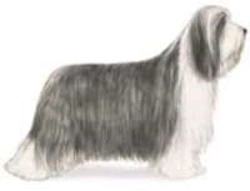
History of the Bearded Collie
The Beardie is a breed of some vintage, being known for his excellent herding and droving skills in the Scottish borders and highlands since the 16th century. He is a hardy dog with amazing stamina, power and agility.
Beardies are believed to be descended from Polish Lowland Sheepdogs brought to Scotland in the 1500s, but there are no records to confirm this. Recent theory has it that the Magyar Komondor was also involved in the Bearded Collie's development.
What we do know
is that at one time,
two types of Bearded Collies existed in Scotland: the Border type, which had a slightly wavy
brown and white coat, and the Highland, which had a gray and white coat.
Eventually, they were mated with the result of being one breed from thereafter.
What we also know is that the Beardie became somewhat of a fashion statement with elite society and favored by artists in the 1700s.
Two of the more famous paintings from that era where a Collie is included in the family portraits, were completed by Gainsborough and Reynolds.
The Beardie continued to be glimped in artworks through the mid 1800s.
By 1891, the Bearded Collie was participating in dog shows around Scotland and by 1897 appeared in the first show in which the breed was classified, according to the Beardie Collie Club.
In 1898 the first Standard of the breed was written by a Mrs. Hall Walker and is pretty much unchanged to this day.
Two world wars interrupted breeding and registration of dogs for a several years and along with that the organization of breed shows. The revival of the Bearded Collie as a show breed
was taken over by a dedicated breeder,
G.O. Willison,
in the late 1940s who also began the first documenting of their history.
Bearded collies made their appearance in the United States sometime during the late 1950s, and by 1976 the breed was registered by the American Kennel Club.
During the 1970s or even earlier, the Beardie had caught the attention of the entertainment industry. So it's no surprise that eventually Bearded Collies became popular in television, movies and catalogs.
With all that charisma, bouncy energy and good looks, plus their natural ability to ham it up, it easy to see why they would be a good choice for the camera.
And, let's not forget that they enjoy being the center of attention!
The Beardie's stardom includes roles in the two Disney films The Shaggy Dog Story, and First Kid; the Agent Cody Banks movie; the television series Please Don't Eat The Daisies, as well as being featured in the Land's End Catalog in 2001.
Tiger, the shaggy dog seen in The Brady Bunch sitcom was most likely a Beardie, and also the one in Little House on the Prairie.
Bearded Collie Video
Here's a look at the Bearded Collie enjoying his bouncy life...
How Active is the Beardie?
Be forewarned, Bearded Collies need a considerable amount of exercise. They are naturally active dogs.
In addition to the minimum daily walk, an opportunity to run off leash would be ideal. If you're a jogger, he not only has the stamina, but will happily go along.
Other ways to use up their high energy are to involve them in competitive dog sports such as
herding, tracking or agility. Beardies are a natural for agility and
easily compete for titles after a few training classes an the advance from Novice to Master.
They love the outdoors, so big back yard for his active nature.
Ideal Living Space
Does best in home with a good size yard where he can play and race around. This breed loves the outdoors, no matter what the
weather. Remember they thrived in the challenging weather of the Scottish Highlands!
Today's Beardie has evolved from his past life as a working dog and is now mainly a family companion. As a result, he now loves to spend most of his time interacting with his family inside the home.
He is very adaptable to sleeping in an outside doghouse if that is your choice, but I personally would not isolate such a social and affectionate dog from his pack.
The Bearded Collie With Children?
A herding breed has the innate instinct to round them up and go after the ones that get out of line! So the Bearded Collie is probably better off with older children who can respect his duties.
Beardies are boysterous at all ages, and love to chase, so keep that in mind. At the same time, they are very sociable and friendly companions.
As with any breed of dog, it pays to err on the side of caution and have an adult
around when pets and children of any age are interacting.
Senior Or Sedentary Families?
While this collie does very well with almost everyone, senior owners or sedentary families, should take into consideration the exercise needs which are very important and have to be maintained.
The ideal is to have a yard or large fenced play area available, plus someone available for daily walks.
Finding A Bearded Collie
If you are looking for a purebred with a pedigree, find a professional breeder and prepare a list of important questions to ask about their breeding program, how stock is selected, what steps they take to ensure healthy litters, and what health test they have done.
After reading this article, you'll be well-informed and ready to meet with a breeder to ask these question before considering a purchase.
Reputable breeders can be found through lists on the American Kennel Club’s website. The cost of a pup is between $1,500-$2,500. Available puppies can also be found in the AKC marketplace: https://marketplace.akc.org/.
For rescues or adoption: https://beardedcollieclub.us/rescue/
or your local animal shelter.
Book Recommendation
An up-to-date reference guide including expert information on selecting a puppy, behavior and health concerns, positive-training methods, socialization and avoiding puppy problems, house-training, obedience, and comprehensive healthcare.
Resource: The Bearded Collie Club of the US
Bearded Collie portrait: https://commons.wikimedia.org/wiki/File:Bearded_Collie_portrait.jpg?uselang=de
Bearded Collie in Wales by McBeard Man, CC BY-SA 4.0, via Wikimedia Commons
Bearded Collie outside in the grass Balbriggan, CC BY 3.0 , via Wikimedia Commons
Bearded Collie Puppy Hari V creativecommons.org/licenses/by/2.0/ by Barney Moss Flickr

